SBM1202: Sustainable Procurement Practices in Australia Report
VerifiedAdded on 2022/12/05
|15
|4481
|234
Report
AI Summary
This report provides an overview of sustainable procurement practices in Australia. It begins with an introduction to sustainable procurement, defining its scope and importance in the context of economic, social, and environmental factors. The report then reviews existing literature on the subject, exploring key concepts like the Triple Bottom Line (TBL) and the role of procurement management. It details principles of sustainable procurement, including demand management, transparency, and stakeholder consideration. The report further examines key concepts such as value for money, whole-of-life costs, and life cycle assessment. It also discusses drivers and focuses on sustainability, including corporate social responsibility and the role of internal drivers. The report then outlines rules and regulations related to sustainable procurement in Australia, including the Local Government Act 1993 (NSW) and the NSW Procurement Policy Framework. It concludes by highlighting the importance of sustainable procurement in the public sector and overall, emphasizing its role in achieving economic, social, and environmental goals.
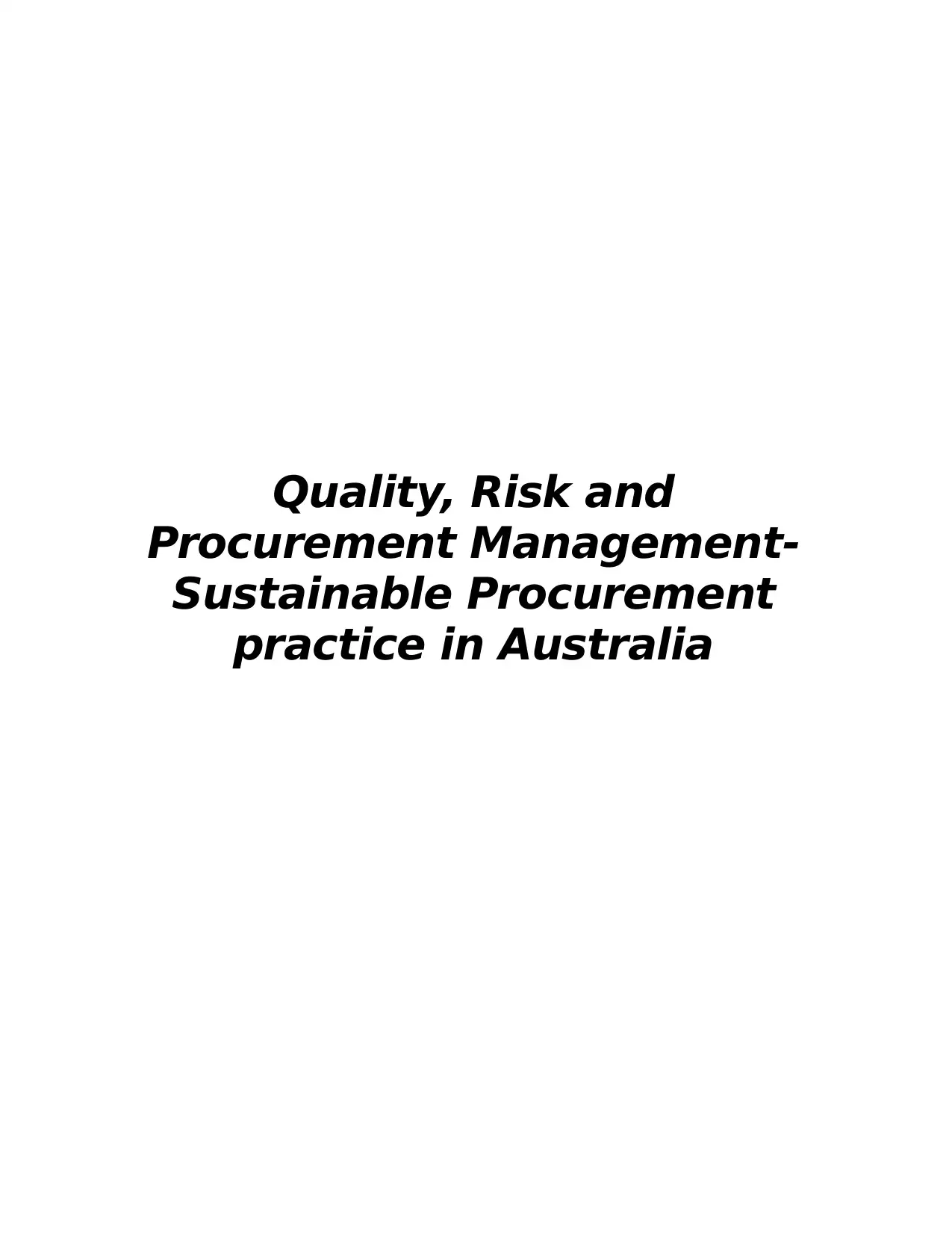
Quality, Risk and
Procurement Management-
Sustainable Procurement
practice in Australia
Procurement Management-
Sustainable Procurement
practice in Australia
Paraphrase This Document
Need a fresh take? Get an instant paraphrase of this document with our AI Paraphraser
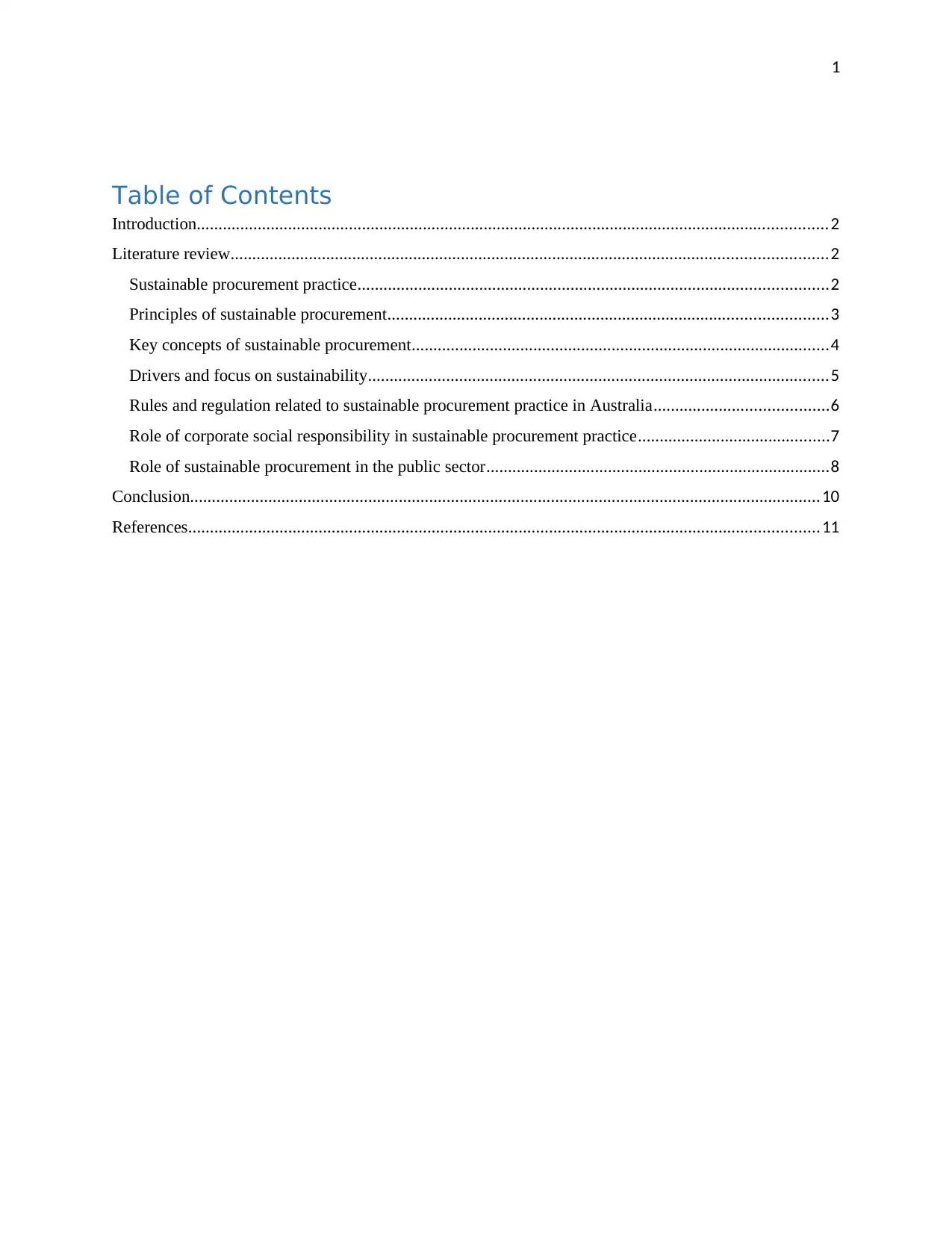
1
Table of Contents
Introduction.................................................................................................................................................2
Literature review.........................................................................................................................................2
Sustainable procurement practice............................................................................................................2
Principles of sustainable procurement.....................................................................................................3
Key concepts of sustainable procurement................................................................................................4
Drivers and focus on sustainability..........................................................................................................5
Rules and regulation related to sustainable procurement practice in Australia........................................6
Role of corporate social responsibility in sustainable procurement practice............................................7
Role of sustainable procurement in the public sector...............................................................................8
Conclusion.................................................................................................................................................10
References.................................................................................................................................................11
Table of Contents
Introduction.................................................................................................................................................2
Literature review.........................................................................................................................................2
Sustainable procurement practice............................................................................................................2
Principles of sustainable procurement.....................................................................................................3
Key concepts of sustainable procurement................................................................................................4
Drivers and focus on sustainability..........................................................................................................5
Rules and regulation related to sustainable procurement practice in Australia........................................6
Role of corporate social responsibility in sustainable procurement practice............................................7
Role of sustainable procurement in the public sector...............................................................................8
Conclusion.................................................................................................................................................10
References.................................................................................................................................................11
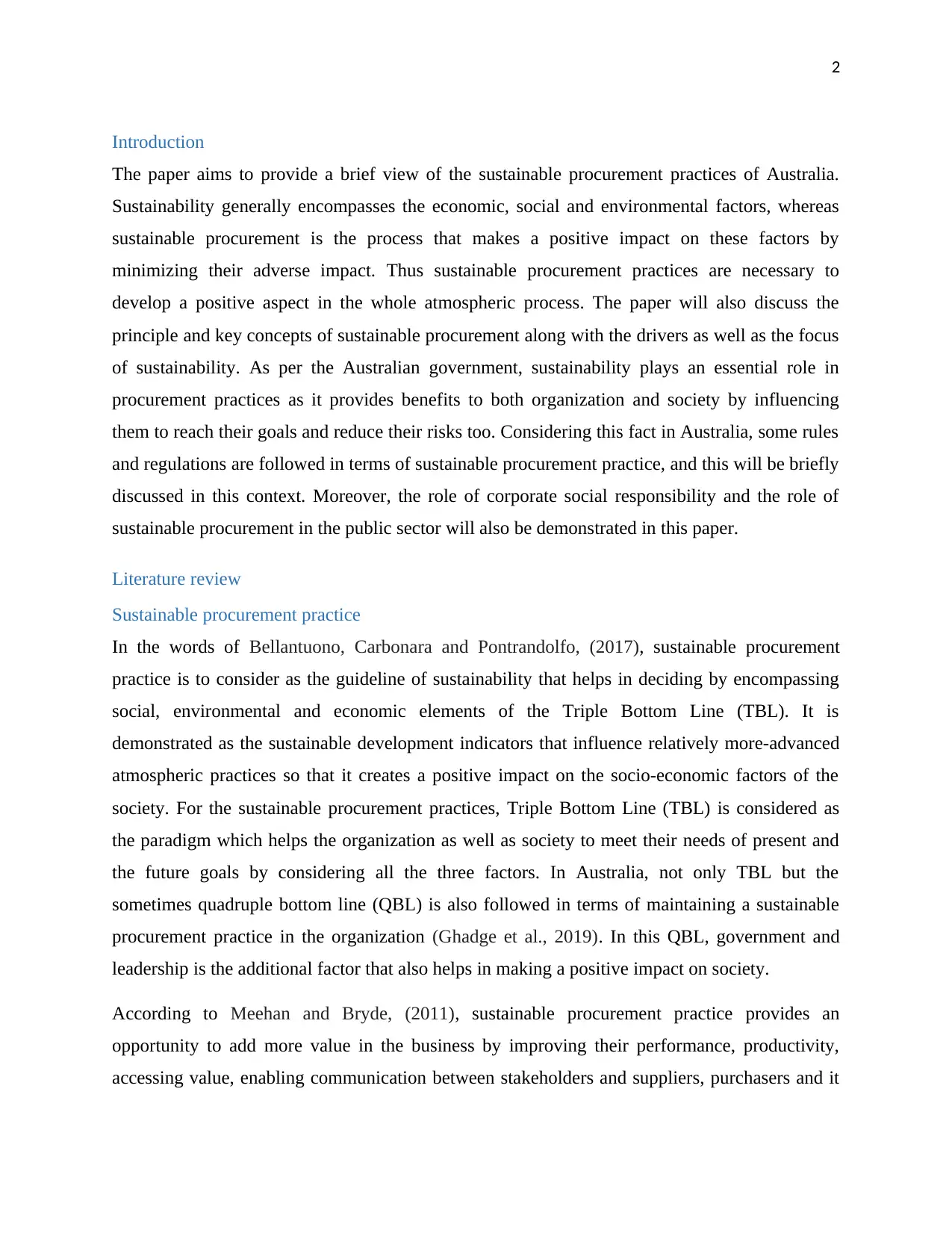
2
Introduction
The paper aims to provide a brief view of the sustainable procurement practices of Australia.
Sustainability generally encompasses the economic, social and environmental factors, whereas
sustainable procurement is the process that makes a positive impact on these factors by
minimizing their adverse impact. Thus sustainable procurement practices are necessary to
develop a positive aspect in the whole atmospheric process. The paper will also discuss the
principle and key concepts of sustainable procurement along with the drivers as well as the focus
of sustainability. As per the Australian government, sustainability plays an essential role in
procurement practices as it provides benefits to both organization and society by influencing
them to reach their goals and reduce their risks too. Considering this fact in Australia, some rules
and regulations are followed in terms of sustainable procurement practice, and this will be briefly
discussed in this context. Moreover, the role of corporate social responsibility and the role of
sustainable procurement in the public sector will also be demonstrated in this paper.
Literature review
Sustainable procurement practice
In the words of Bellantuono, Carbonara and Pontrandolfo, (2017), sustainable procurement
practice is to consider as the guideline of sustainability that helps in deciding by encompassing
social, environmental and economic elements of the Triple Bottom Line (TBL). It is
demonstrated as the sustainable development indicators that influence relatively more-advanced
atmospheric practices so that it creates a positive impact on the socio-economic factors of the
society. For the sustainable procurement practices, Triple Bottom Line (TBL) is considered as
the paradigm which helps the organization as well as society to meet their needs of present and
the future goals by considering all the three factors. In Australia, not only TBL but the
sometimes quadruple bottom line (QBL) is also followed in terms of maintaining a sustainable
procurement practice in the organization (Ghadge et al., 2019). In this QBL, government and
leadership is the additional factor that also helps in making a positive impact on society.
According to Meehan and Bryde, (2011), sustainable procurement practice provides an
opportunity to add more value in the business by improving their performance, productivity,
accessing value, enabling communication between stakeholders and suppliers, purchasers and it
Introduction
The paper aims to provide a brief view of the sustainable procurement practices of Australia.
Sustainability generally encompasses the economic, social and environmental factors, whereas
sustainable procurement is the process that makes a positive impact on these factors by
minimizing their adverse impact. Thus sustainable procurement practices are necessary to
develop a positive aspect in the whole atmospheric process. The paper will also discuss the
principle and key concepts of sustainable procurement along with the drivers as well as the focus
of sustainability. As per the Australian government, sustainability plays an essential role in
procurement practices as it provides benefits to both organization and society by influencing
them to reach their goals and reduce their risks too. Considering this fact in Australia, some rules
and regulations are followed in terms of sustainable procurement practice, and this will be briefly
discussed in this context. Moreover, the role of corporate social responsibility and the role of
sustainable procurement in the public sector will also be demonstrated in this paper.
Literature review
Sustainable procurement practice
In the words of Bellantuono, Carbonara and Pontrandolfo, (2017), sustainable procurement
practice is to consider as the guideline of sustainability that helps in deciding by encompassing
social, environmental and economic elements of the Triple Bottom Line (TBL). It is
demonstrated as the sustainable development indicators that influence relatively more-advanced
atmospheric practices so that it creates a positive impact on the socio-economic factors of the
society. For the sustainable procurement practices, Triple Bottom Line (TBL) is considered as
the paradigm which helps the organization as well as society to meet their needs of present and
the future goals by considering all the three factors. In Australia, not only TBL but the
sometimes quadruple bottom line (QBL) is also followed in terms of maintaining a sustainable
procurement practice in the organization (Ghadge et al., 2019). In this QBL, government and
leadership is the additional factor that also helps in making a positive impact on society.
According to Meehan and Bryde, (2011), sustainable procurement practice provides an
opportunity to add more value in the business by improving their performance, productivity,
accessing value, enabling communication between stakeholders and suppliers, purchasers and it
⊘ This is a preview!⊘
Do you want full access?
Subscribe today to unlock all pages.

Trusted by 1+ million students worldwide
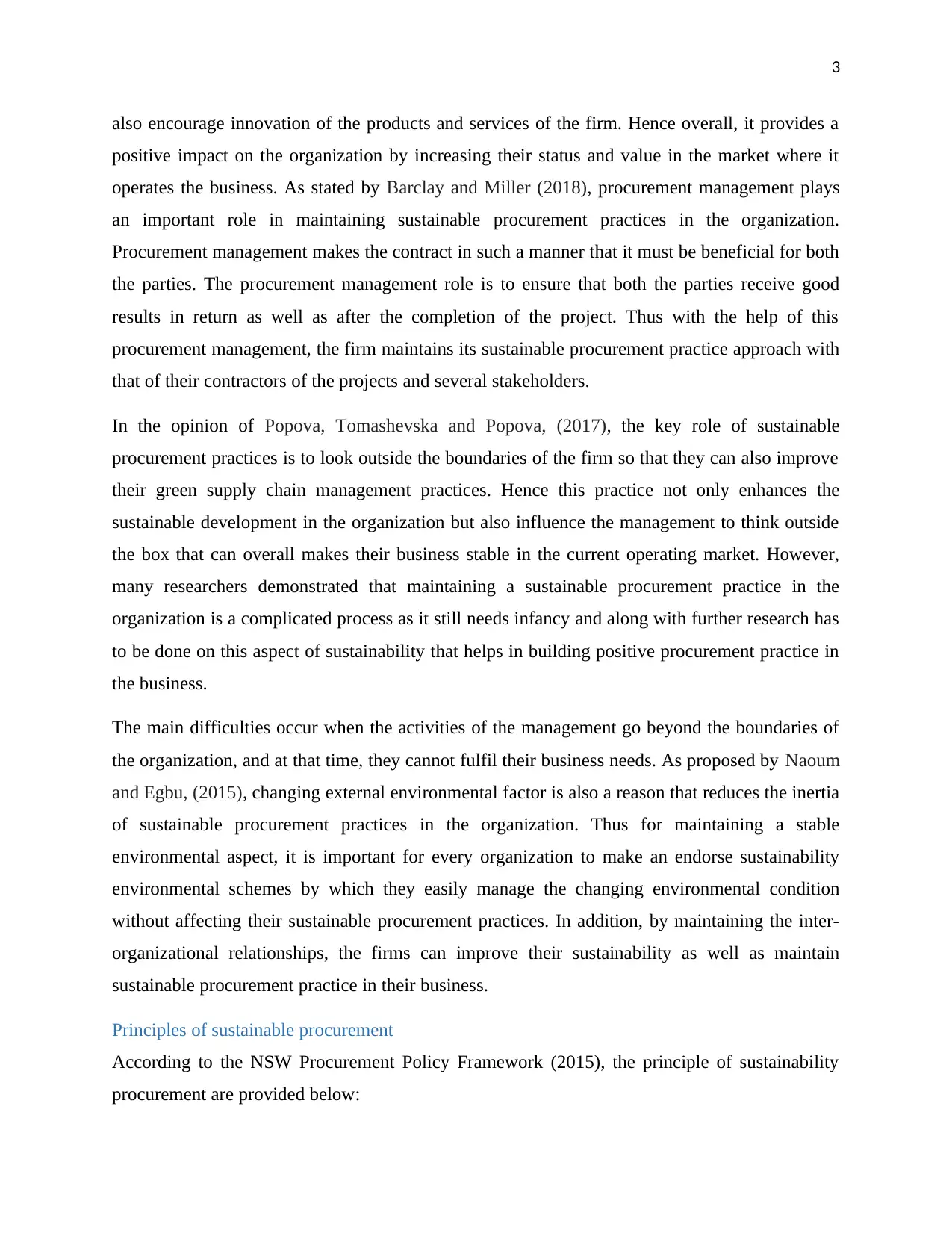
3
also encourage innovation of the products and services of the firm. Hence overall, it provides a
positive impact on the organization by increasing their status and value in the market where it
operates the business. As stated by Barclay and Miller (2018), procurement management plays
an important role in maintaining sustainable procurement practices in the organization.
Procurement management makes the contract in such a manner that it must be beneficial for both
the parties. The procurement management role is to ensure that both the parties receive good
results in return as well as after the completion of the project. Thus with the help of this
procurement management, the firm maintains its sustainable procurement practice approach with
that of their contractors of the projects and several stakeholders.
In the opinion of Popova, Tomashevska and Popova, (2017), the key role of sustainable
procurement practices is to look outside the boundaries of the firm so that they can also improve
their green supply chain management practices. Hence this practice not only enhances the
sustainable development in the organization but also influence the management to think outside
the box that can overall makes their business stable in the current operating market. However,
many researchers demonstrated that maintaining a sustainable procurement practice in the
organization is a complicated process as it still needs infancy and along with further research has
to be done on this aspect of sustainability that helps in building positive procurement practice in
the business.
The main difficulties occur when the activities of the management go beyond the boundaries of
the organization, and at that time, they cannot fulfil their business needs. As proposed by Naoum
and Egbu, (2015), changing external environmental factor is also a reason that reduces the inertia
of sustainable procurement practices in the organization. Thus for maintaining a stable
environmental aspect, it is important for every organization to make an endorse sustainability
environmental schemes by which they easily manage the changing environmental condition
without affecting their sustainable procurement practices. In addition, by maintaining the inter-
organizational relationships, the firms can improve their sustainability as well as maintain
sustainable procurement practice in their business.
Principles of sustainable procurement
According to the NSW Procurement Policy Framework (2015), the principle of sustainability
procurement are provided below:
also encourage innovation of the products and services of the firm. Hence overall, it provides a
positive impact on the organization by increasing their status and value in the market where it
operates the business. As stated by Barclay and Miller (2018), procurement management plays
an important role in maintaining sustainable procurement practices in the organization.
Procurement management makes the contract in such a manner that it must be beneficial for both
the parties. The procurement management role is to ensure that both the parties receive good
results in return as well as after the completion of the project. Thus with the help of this
procurement management, the firm maintains its sustainable procurement practice approach with
that of their contractors of the projects and several stakeholders.
In the opinion of Popova, Tomashevska and Popova, (2017), the key role of sustainable
procurement practices is to look outside the boundaries of the firm so that they can also improve
their green supply chain management practices. Hence this practice not only enhances the
sustainable development in the organization but also influence the management to think outside
the box that can overall makes their business stable in the current operating market. However,
many researchers demonstrated that maintaining a sustainable procurement practice in the
organization is a complicated process as it still needs infancy and along with further research has
to be done on this aspect of sustainability that helps in building positive procurement practice in
the business.
The main difficulties occur when the activities of the management go beyond the boundaries of
the organization, and at that time, they cannot fulfil their business needs. As proposed by Naoum
and Egbu, (2015), changing external environmental factor is also a reason that reduces the inertia
of sustainable procurement practices in the organization. Thus for maintaining a stable
environmental aspect, it is important for every organization to make an endorse sustainability
environmental schemes by which they easily manage the changing environmental condition
without affecting their sustainable procurement practices. In addition, by maintaining the inter-
organizational relationships, the firms can improve their sustainability as well as maintain
sustainable procurement practice in their business.
Principles of sustainable procurement
According to the NSW Procurement Policy Framework (2015), the principle of sustainability
procurement are provided below:
Paraphrase This Document
Need a fresh take? Get an instant paraphrase of this document with our AI Paraphraser
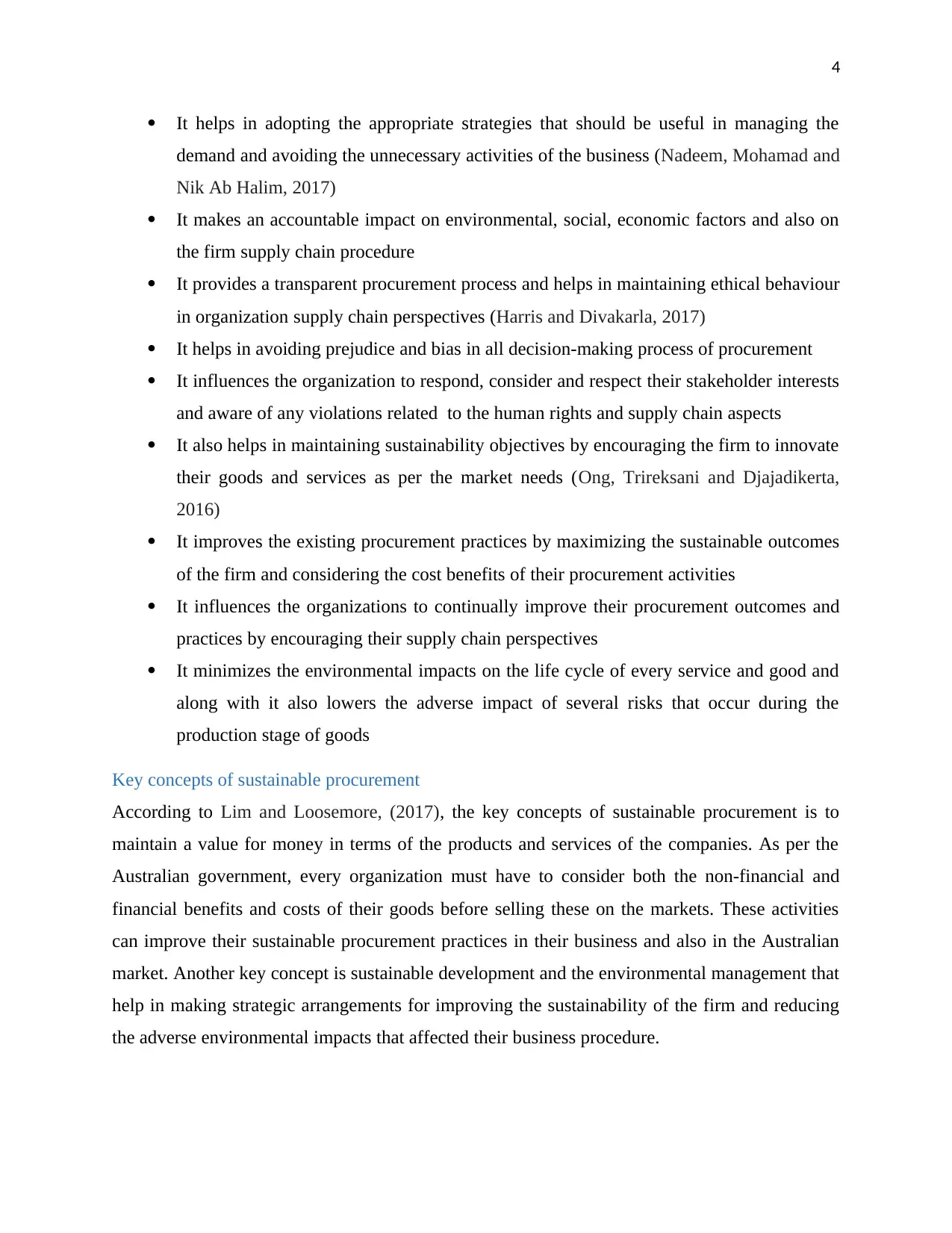
4
It helps in adopting the appropriate strategies that should be useful in managing the
demand and avoiding the unnecessary activities of the business (Nadeem, Mohamad and
Nik Ab Halim, 2017)
It makes an accountable impact on environmental, social, economic factors and also on
the firm supply chain procedure
It provides a transparent procurement process and helps in maintaining ethical behaviour
in organization supply chain perspectives (Harris and Divakarla, 2017)
It helps in avoiding prejudice and bias in all decision-making process of procurement
It influences the organization to respond, consider and respect their stakeholder interests
and aware of any violations related to the human rights and supply chain aspects
It also helps in maintaining sustainability objectives by encouraging the firm to innovate
their goods and services as per the market needs (Ong, Trireksani and Djajadikerta,
2016)
It improves the existing procurement practices by maximizing the sustainable outcomes
of the firm and considering the cost benefits of their procurement activities
It influences the organizations to continually improve their procurement outcomes and
practices by encouraging their supply chain perspectives
It minimizes the environmental impacts on the life cycle of every service and good and
along with it also lowers the adverse impact of several risks that occur during the
production stage of goods
Key concepts of sustainable procurement
According to Lim and Loosemore, (2017), the key concepts of sustainable procurement is to
maintain a value for money in terms of the products and services of the companies. As per the
Australian government, every organization must have to consider both the non-financial and
financial benefits and costs of their goods before selling these on the markets. These activities
can improve their sustainable procurement practices in their business and also in the Australian
market. Another key concept is sustainable development and the environmental management that
help in making strategic arrangements for improving the sustainability of the firm and reducing
the adverse environmental impacts that affected their business procedure.
It helps in adopting the appropriate strategies that should be useful in managing the
demand and avoiding the unnecessary activities of the business (Nadeem, Mohamad and
Nik Ab Halim, 2017)
It makes an accountable impact on environmental, social, economic factors and also on
the firm supply chain procedure
It provides a transparent procurement process and helps in maintaining ethical behaviour
in organization supply chain perspectives (Harris and Divakarla, 2017)
It helps in avoiding prejudice and bias in all decision-making process of procurement
It influences the organization to respond, consider and respect their stakeholder interests
and aware of any violations related to the human rights and supply chain aspects
It also helps in maintaining sustainability objectives by encouraging the firm to innovate
their goods and services as per the market needs (Ong, Trireksani and Djajadikerta,
2016)
It improves the existing procurement practices by maximizing the sustainable outcomes
of the firm and considering the cost benefits of their procurement activities
It influences the organizations to continually improve their procurement outcomes and
practices by encouraging their supply chain perspectives
It minimizes the environmental impacts on the life cycle of every service and good and
along with it also lowers the adverse impact of several risks that occur during the
production stage of goods
Key concepts of sustainable procurement
According to Lim and Loosemore, (2017), the key concepts of sustainable procurement is to
maintain a value for money in terms of the products and services of the companies. As per the
Australian government, every organization must have to consider both the non-financial and
financial benefits and costs of their goods before selling these on the markets. These activities
can improve their sustainable procurement practices in their business and also in the Australian
market. Another key concept is sustainable development and the environmental management that
help in making strategic arrangements for improving the sustainability of the firm and reducing
the adverse environmental impacts that affected their business procedure.
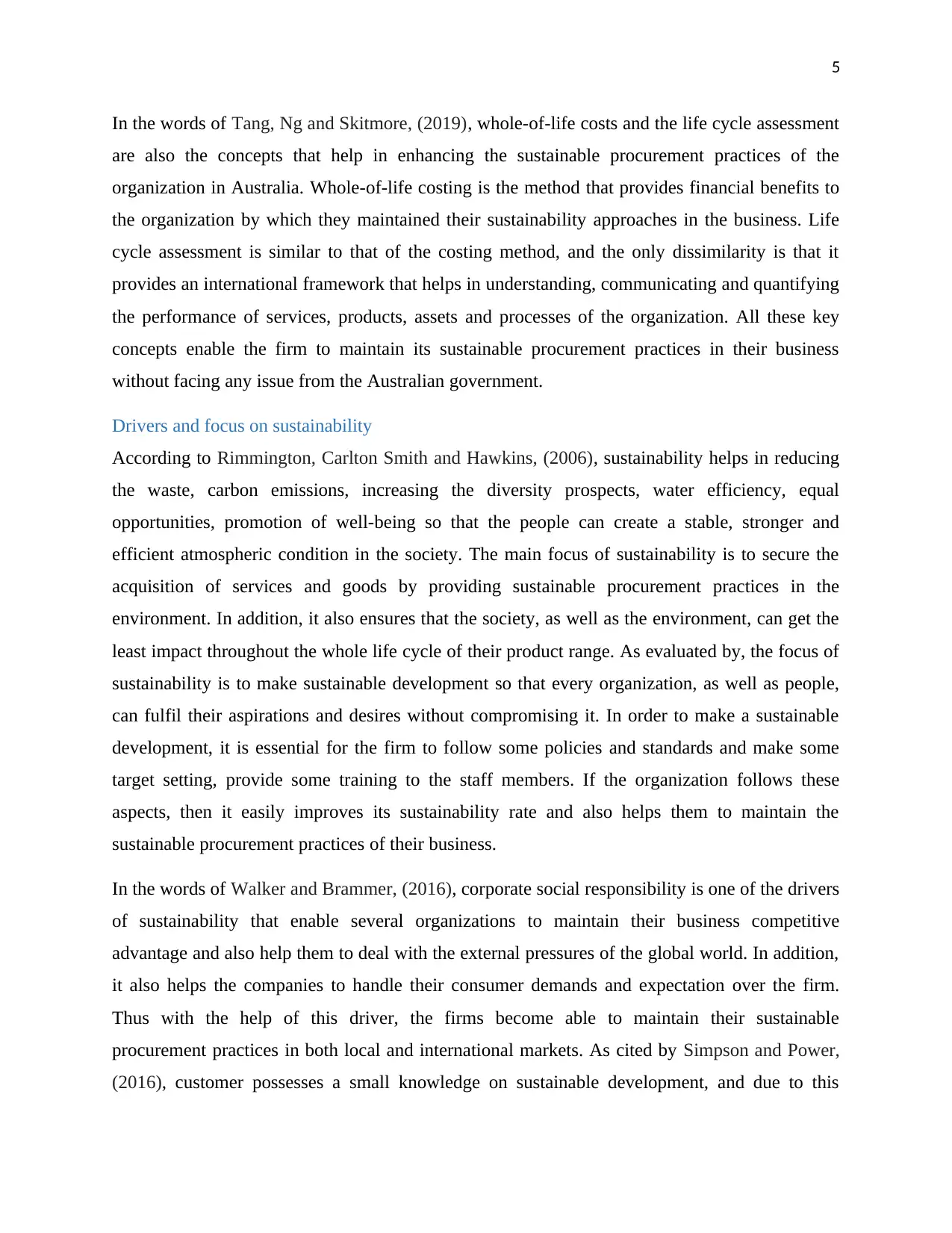
5
In the words of Tang, Ng and Skitmore, (2019), whole-of-life costs and the life cycle assessment
are also the concepts that help in enhancing the sustainable procurement practices of the
organization in Australia. Whole-of-life costing is the method that provides financial benefits to
the organization by which they maintained their sustainability approaches in the business. Life
cycle assessment is similar to that of the costing method, and the only dissimilarity is that it
provides an international framework that helps in understanding, communicating and quantifying
the performance of services, products, assets and processes of the organization. All these key
concepts enable the firm to maintain its sustainable procurement practices in their business
without facing any issue from the Australian government.
Drivers and focus on sustainability
According to Rimmington, Carlton Smith and Hawkins, (2006), sustainability helps in reducing
the waste, carbon emissions, increasing the diversity prospects, water efficiency, equal
opportunities, promotion of well-being so that the people can create a stable, stronger and
efficient atmospheric condition in the society. The main focus of sustainability is to secure the
acquisition of services and goods by providing sustainable procurement practices in the
environment. In addition, it also ensures that the society, as well as the environment, can get the
least impact throughout the whole life cycle of their product range. As evaluated by, the focus of
sustainability is to make sustainable development so that every organization, as well as people,
can fulfil their aspirations and desires without compromising it. In order to make a sustainable
development, it is essential for the firm to follow some policies and standards and make some
target setting, provide some training to the staff members. If the organization follows these
aspects, then it easily improves its sustainability rate and also helps them to maintain the
sustainable procurement practices of their business.
In the words of Walker and Brammer, (2016), corporate social responsibility is one of the drivers
of sustainability that enable several organizations to maintain their business competitive
advantage and also help them to deal with the external pressures of the global world. In addition,
it also helps the companies to handle their consumer demands and expectation over the firm.
Thus with the help of this driver, the firms become able to maintain their sustainable
procurement practices in both local and international markets. As cited by Simpson and Power,
(2016), customer possesses a small knowledge on sustainable development, and due to this
In the words of Tang, Ng and Skitmore, (2019), whole-of-life costs and the life cycle assessment
are also the concepts that help in enhancing the sustainable procurement practices of the
organization in Australia. Whole-of-life costing is the method that provides financial benefits to
the organization by which they maintained their sustainability approaches in the business. Life
cycle assessment is similar to that of the costing method, and the only dissimilarity is that it
provides an international framework that helps in understanding, communicating and quantifying
the performance of services, products, assets and processes of the organization. All these key
concepts enable the firm to maintain its sustainable procurement practices in their business
without facing any issue from the Australian government.
Drivers and focus on sustainability
According to Rimmington, Carlton Smith and Hawkins, (2006), sustainability helps in reducing
the waste, carbon emissions, increasing the diversity prospects, water efficiency, equal
opportunities, promotion of well-being so that the people can create a stable, stronger and
efficient atmospheric condition in the society. The main focus of sustainability is to secure the
acquisition of services and goods by providing sustainable procurement practices in the
environment. In addition, it also ensures that the society, as well as the environment, can get the
least impact throughout the whole life cycle of their product range. As evaluated by, the focus of
sustainability is to make sustainable development so that every organization, as well as people,
can fulfil their aspirations and desires without compromising it. In order to make a sustainable
development, it is essential for the firm to follow some policies and standards and make some
target setting, provide some training to the staff members. If the organization follows these
aspects, then it easily improves its sustainability rate and also helps them to maintain the
sustainable procurement practices of their business.
In the words of Walker and Brammer, (2016), corporate social responsibility is one of the drivers
of sustainability that enable several organizations to maintain their business competitive
advantage and also help them to deal with the external pressures of the global world. In addition,
it also helps the companies to handle their consumer demands and expectation over the firm.
Thus with the help of this driver, the firms become able to maintain their sustainable
procurement practices in both local and international markets. As cited by Simpson and Power,
(2016), customer possesses a small knowledge on sustainable development, and due to this
⊘ This is a preview!⊘
Do you want full access?
Subscribe today to unlock all pages.

Trusted by 1+ million students worldwide
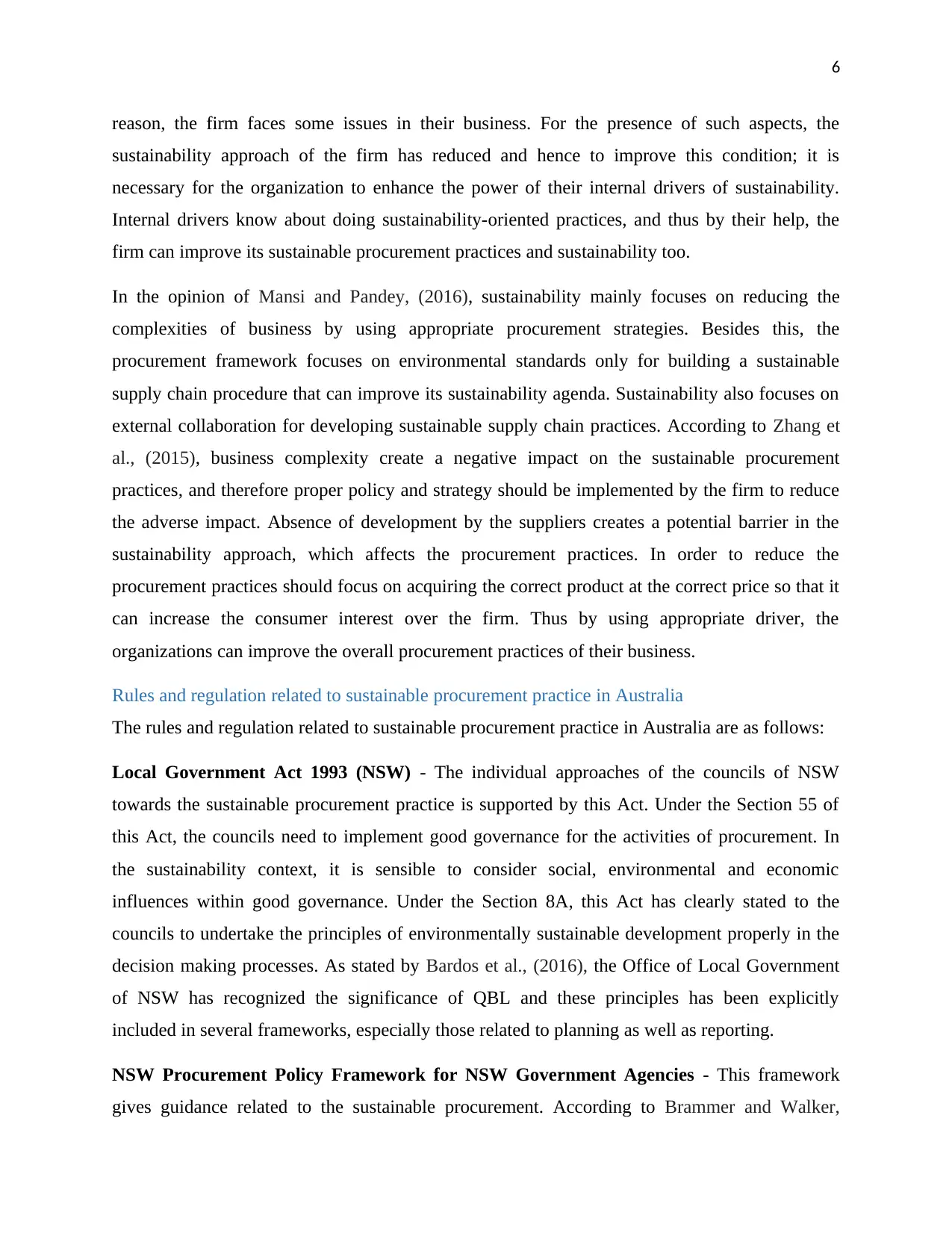
6
reason, the firm faces some issues in their business. For the presence of such aspects, the
sustainability approach of the firm has reduced and hence to improve this condition; it is
necessary for the organization to enhance the power of their internal drivers of sustainability.
Internal drivers know about doing sustainability-oriented practices, and thus by their help, the
firm can improve its sustainable procurement practices and sustainability too.
In the opinion of Mansi and Pandey, (2016), sustainability mainly focuses on reducing the
complexities of business by using appropriate procurement strategies. Besides this, the
procurement framework focuses on environmental standards only for building a sustainable
supply chain procedure that can improve its sustainability agenda. Sustainability also focuses on
external collaboration for developing sustainable supply chain practices. According to Zhang et
al., (2015), business complexity create a negative impact on the sustainable procurement
practices, and therefore proper policy and strategy should be implemented by the firm to reduce
the adverse impact. Absence of development by the suppliers creates a potential barrier in the
sustainability approach, which affects the procurement practices. In order to reduce the
procurement practices should focus on acquiring the correct product at the correct price so that it
can increase the consumer interest over the firm. Thus by using appropriate driver, the
organizations can improve the overall procurement practices of their business.
Rules and regulation related to sustainable procurement practice in Australia
The rules and regulation related to sustainable procurement practice in Australia are as follows:
Local Government Act 1993 (NSW) - The individual approaches of the councils of NSW
towards the sustainable procurement practice is supported by this Act. Under the Section 55 of
this Act, the councils need to implement good governance for the activities of procurement. In
the sustainability context, it is sensible to consider social, environmental and economic
influences within good governance. Under the Section 8A, this Act has clearly stated to the
councils to undertake the principles of environmentally sustainable development properly in the
decision making processes. As stated by Bardos et al., (2016), the Office of Local Government
of NSW has recognized the significance of QBL and these principles has been explicitly
included in several frameworks, especially those related to planning as well as reporting.
NSW Procurement Policy Framework for NSW Government Agencies - This framework
gives guidance related to the sustainable procurement. According to Brammer and Walker,
reason, the firm faces some issues in their business. For the presence of such aspects, the
sustainability approach of the firm has reduced and hence to improve this condition; it is
necessary for the organization to enhance the power of their internal drivers of sustainability.
Internal drivers know about doing sustainability-oriented practices, and thus by their help, the
firm can improve its sustainable procurement practices and sustainability too.
In the opinion of Mansi and Pandey, (2016), sustainability mainly focuses on reducing the
complexities of business by using appropriate procurement strategies. Besides this, the
procurement framework focuses on environmental standards only for building a sustainable
supply chain procedure that can improve its sustainability agenda. Sustainability also focuses on
external collaboration for developing sustainable supply chain practices. According to Zhang et
al., (2015), business complexity create a negative impact on the sustainable procurement
practices, and therefore proper policy and strategy should be implemented by the firm to reduce
the adverse impact. Absence of development by the suppliers creates a potential barrier in the
sustainability approach, which affects the procurement practices. In order to reduce the
procurement practices should focus on acquiring the correct product at the correct price so that it
can increase the consumer interest over the firm. Thus by using appropriate driver, the
organizations can improve the overall procurement practices of their business.
Rules and regulation related to sustainable procurement practice in Australia
The rules and regulation related to sustainable procurement practice in Australia are as follows:
Local Government Act 1993 (NSW) - The individual approaches of the councils of NSW
towards the sustainable procurement practice is supported by this Act. Under the Section 55 of
this Act, the councils need to implement good governance for the activities of procurement. In
the sustainability context, it is sensible to consider social, environmental and economic
influences within good governance. Under the Section 8A, this Act has clearly stated to the
councils to undertake the principles of environmentally sustainable development properly in the
decision making processes. As stated by Bardos et al., (2016), the Office of Local Government
of NSW has recognized the significance of QBL and these principles has been explicitly
included in several frameworks, especially those related to planning as well as reporting.
NSW Procurement Policy Framework for NSW Government Agencies - This framework
gives guidance related to the sustainable procurement. According to Brammer and Walker,
Paraphrase This Document
Need a fresh take? Get an instant paraphrase of this document with our AI Paraphraser
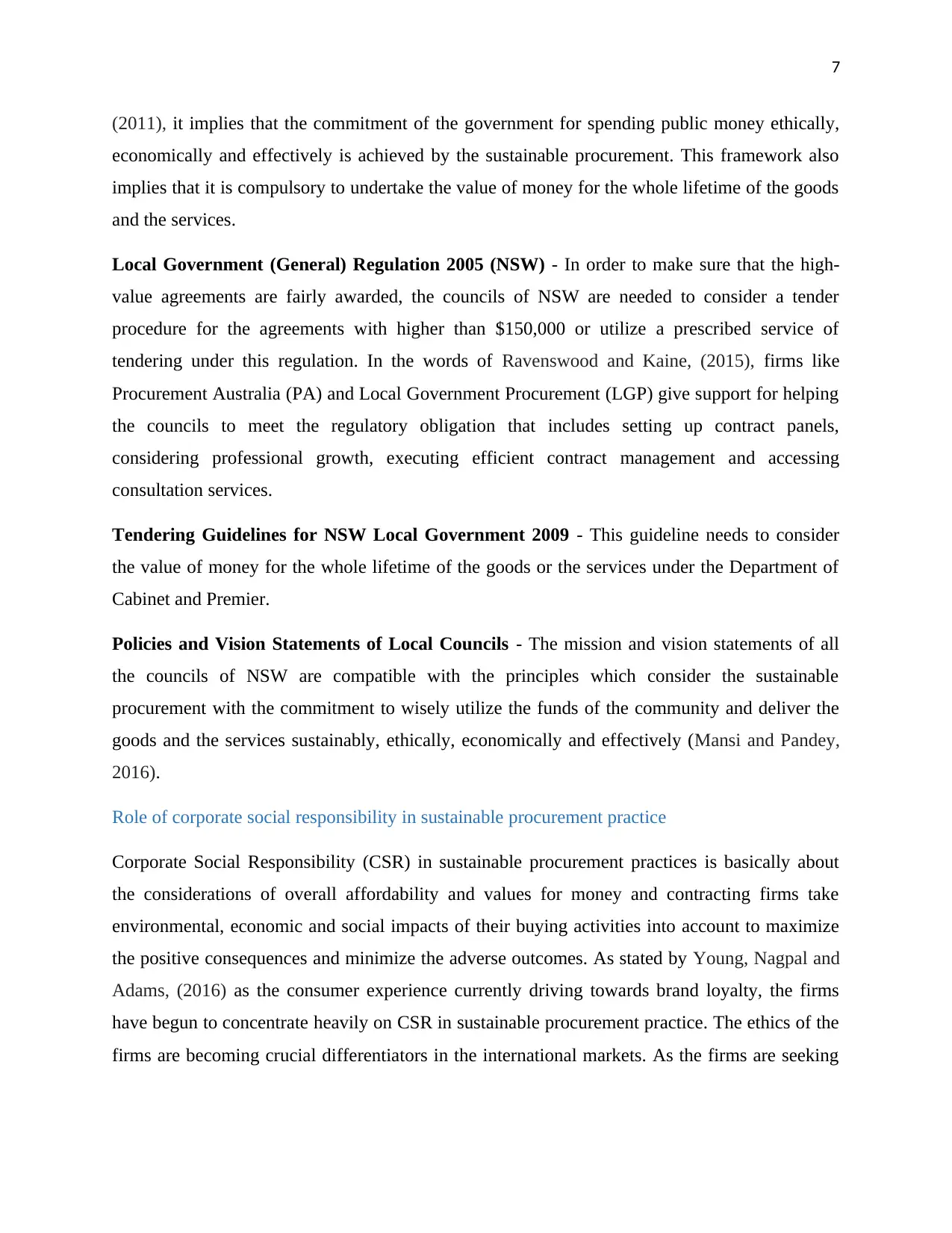
7
(2011), it implies that the commitment of the government for spending public money ethically,
economically and effectively is achieved by the sustainable procurement. This framework also
implies that it is compulsory to undertake the value of money for the whole lifetime of the goods
and the services.
Local Government (General) Regulation 2005 (NSW) - In order to make sure that the high-
value agreements are fairly awarded, the councils of NSW are needed to consider a tender
procedure for the agreements with higher than $150,000 or utilize a prescribed service of
tendering under this regulation. In the words of Ravenswood and Kaine, (2015), firms like
Procurement Australia (PA) and Local Government Procurement (LGP) give support for helping
the councils to meet the regulatory obligation that includes setting up contract panels,
considering professional growth, executing efficient contract management and accessing
consultation services.
Tendering Guidelines for NSW Local Government 2009 - This guideline needs to consider
the value of money for the whole lifetime of the goods or the services under the Department of
Cabinet and Premier.
Policies and Vision Statements of Local Councils - The mission and vision statements of all
the councils of NSW are compatible with the principles which consider the sustainable
procurement with the commitment to wisely utilize the funds of the community and deliver the
goods and the services sustainably, ethically, economically and effectively (Mansi and Pandey,
2016).
Role of corporate social responsibility in sustainable procurement practice
Corporate Social Responsibility (CSR) in sustainable procurement practices is basically about
the considerations of overall affordability and values for money and contracting firms take
environmental, economic and social impacts of their buying activities into account to maximize
the positive consequences and minimize the adverse outcomes. As stated by Young, Nagpal and
Adams, (2016) as the consumer experience currently driving towards brand loyalty, the firms
have begun to concentrate heavily on CSR in sustainable procurement practice. The ethics of the
firms are becoming crucial differentiators in the international markets. As the firms are seeking
(2011), it implies that the commitment of the government for spending public money ethically,
economically and effectively is achieved by the sustainable procurement. This framework also
implies that it is compulsory to undertake the value of money for the whole lifetime of the goods
and the services.
Local Government (General) Regulation 2005 (NSW) - In order to make sure that the high-
value agreements are fairly awarded, the councils of NSW are needed to consider a tender
procedure for the agreements with higher than $150,000 or utilize a prescribed service of
tendering under this regulation. In the words of Ravenswood and Kaine, (2015), firms like
Procurement Australia (PA) and Local Government Procurement (LGP) give support for helping
the councils to meet the regulatory obligation that includes setting up contract panels,
considering professional growth, executing efficient contract management and accessing
consultation services.
Tendering Guidelines for NSW Local Government 2009 - This guideline needs to consider
the value of money for the whole lifetime of the goods or the services under the Department of
Cabinet and Premier.
Policies and Vision Statements of Local Councils - The mission and vision statements of all
the councils of NSW are compatible with the principles which consider the sustainable
procurement with the commitment to wisely utilize the funds of the community and deliver the
goods and the services sustainably, ethically, economically and effectively (Mansi and Pandey,
2016).
Role of corporate social responsibility in sustainable procurement practice
Corporate Social Responsibility (CSR) in sustainable procurement practices is basically about
the considerations of overall affordability and values for money and contracting firms take
environmental, economic and social impacts of their buying activities into account to maximize
the positive consequences and minimize the adverse outcomes. As stated by Young, Nagpal and
Adams, (2016) as the consumer experience currently driving towards brand loyalty, the firms
have begun to concentrate heavily on CSR in sustainable procurement practice. The ethics of the
firms are becoming crucial differentiators in the international markets. As the firms are seeking
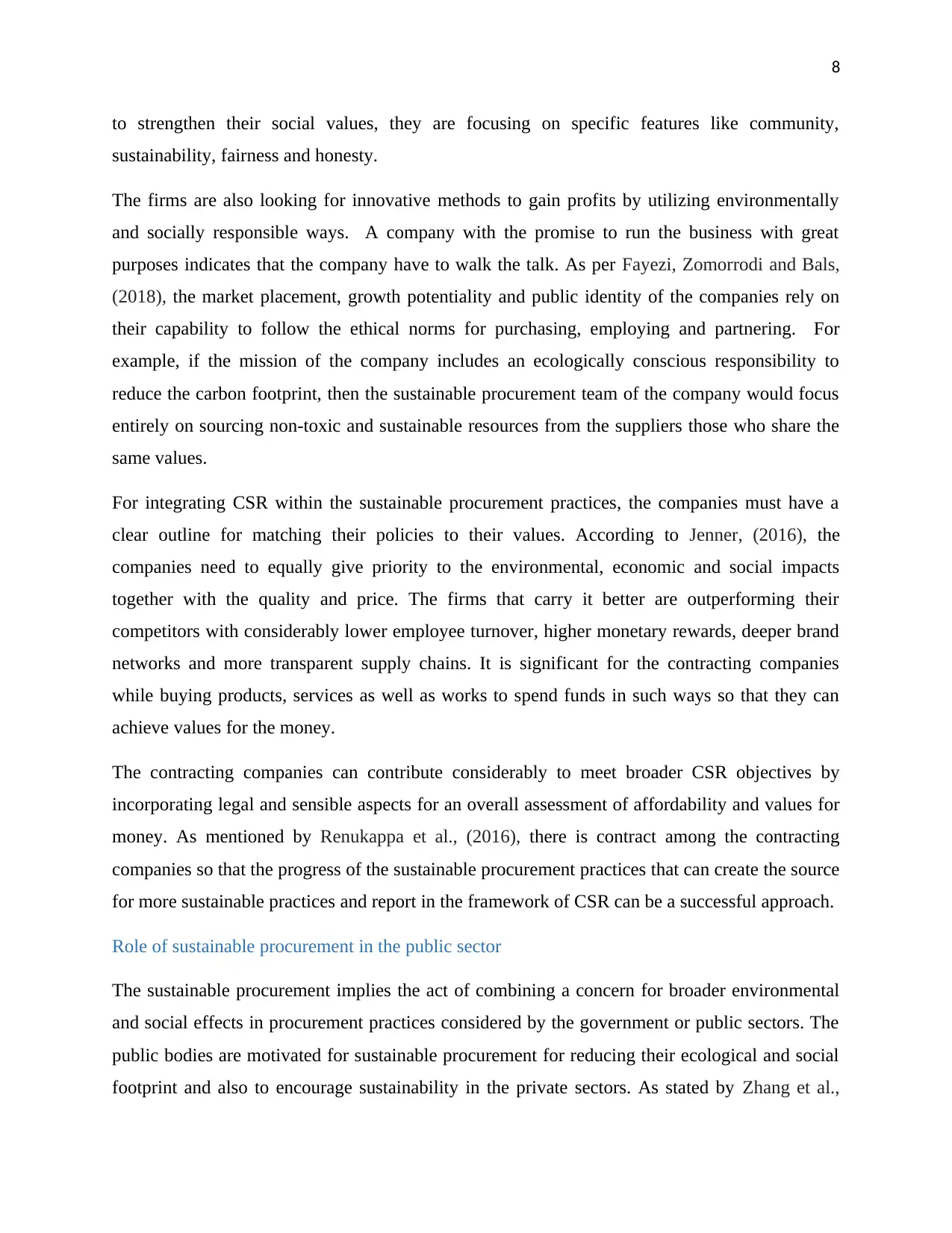
8
to strengthen their social values, they are focusing on specific features like community,
sustainability, fairness and honesty.
The firms are also looking for innovative methods to gain profits by utilizing environmentally
and socially responsible ways. A company with the promise to run the business with great
purposes indicates that the company have to walk the talk. As per Fayezi, Zomorrodi and Bals,
(2018), the market placement, growth potentiality and public identity of the companies rely on
their capability to follow the ethical norms for purchasing, employing and partnering. For
example, if the mission of the company includes an ecologically conscious responsibility to
reduce the carbon footprint, then the sustainable procurement team of the company would focus
entirely on sourcing non-toxic and sustainable resources from the suppliers those who share the
same values.
For integrating CSR within the sustainable procurement practices, the companies must have a
clear outline for matching their policies to their values. According to Jenner, (2016), the
companies need to equally give priority to the environmental, economic and social impacts
together with the quality and price. The firms that carry it better are outperforming their
competitors with considerably lower employee turnover, higher monetary rewards, deeper brand
networks and more transparent supply chains. It is significant for the contracting companies
while buying products, services as well as works to spend funds in such ways so that they can
achieve values for the money.
The contracting companies can contribute considerably to meet broader CSR objectives by
incorporating legal and sensible aspects for an overall assessment of affordability and values for
money. As mentioned by Renukappa et al., (2016), there is contract among the contracting
companies so that the progress of the sustainable procurement practices that can create the source
for more sustainable practices and report in the framework of CSR can be a successful approach.
Role of sustainable procurement in the public sector
The sustainable procurement implies the act of combining a concern for broader environmental
and social effects in procurement practices considered by the government or public sectors. The
public bodies are motivated for sustainable procurement for reducing their ecological and social
footprint and also to encourage sustainability in the private sectors. As stated by Zhang et al.,
to strengthen their social values, they are focusing on specific features like community,
sustainability, fairness and honesty.
The firms are also looking for innovative methods to gain profits by utilizing environmentally
and socially responsible ways. A company with the promise to run the business with great
purposes indicates that the company have to walk the talk. As per Fayezi, Zomorrodi and Bals,
(2018), the market placement, growth potentiality and public identity of the companies rely on
their capability to follow the ethical norms for purchasing, employing and partnering. For
example, if the mission of the company includes an ecologically conscious responsibility to
reduce the carbon footprint, then the sustainable procurement team of the company would focus
entirely on sourcing non-toxic and sustainable resources from the suppliers those who share the
same values.
For integrating CSR within the sustainable procurement practices, the companies must have a
clear outline for matching their policies to their values. According to Jenner, (2016), the
companies need to equally give priority to the environmental, economic and social impacts
together with the quality and price. The firms that carry it better are outperforming their
competitors with considerably lower employee turnover, higher monetary rewards, deeper brand
networks and more transparent supply chains. It is significant for the contracting companies
while buying products, services as well as works to spend funds in such ways so that they can
achieve values for the money.
The contracting companies can contribute considerably to meet broader CSR objectives by
incorporating legal and sensible aspects for an overall assessment of affordability and values for
money. As mentioned by Renukappa et al., (2016), there is contract among the contracting
companies so that the progress of the sustainable procurement practices that can create the source
for more sustainable practices and report in the framework of CSR can be a successful approach.
Role of sustainable procurement in the public sector
The sustainable procurement implies the act of combining a concern for broader environmental
and social effects in procurement practices considered by the government or public sectors. The
public bodies are motivated for sustainable procurement for reducing their ecological and social
footprint and also to encourage sustainability in the private sectors. As stated by Zhang et al.,
⊘ This is a preview!⊘
Do you want full access?
Subscribe today to unlock all pages.

Trusted by 1+ million students worldwide
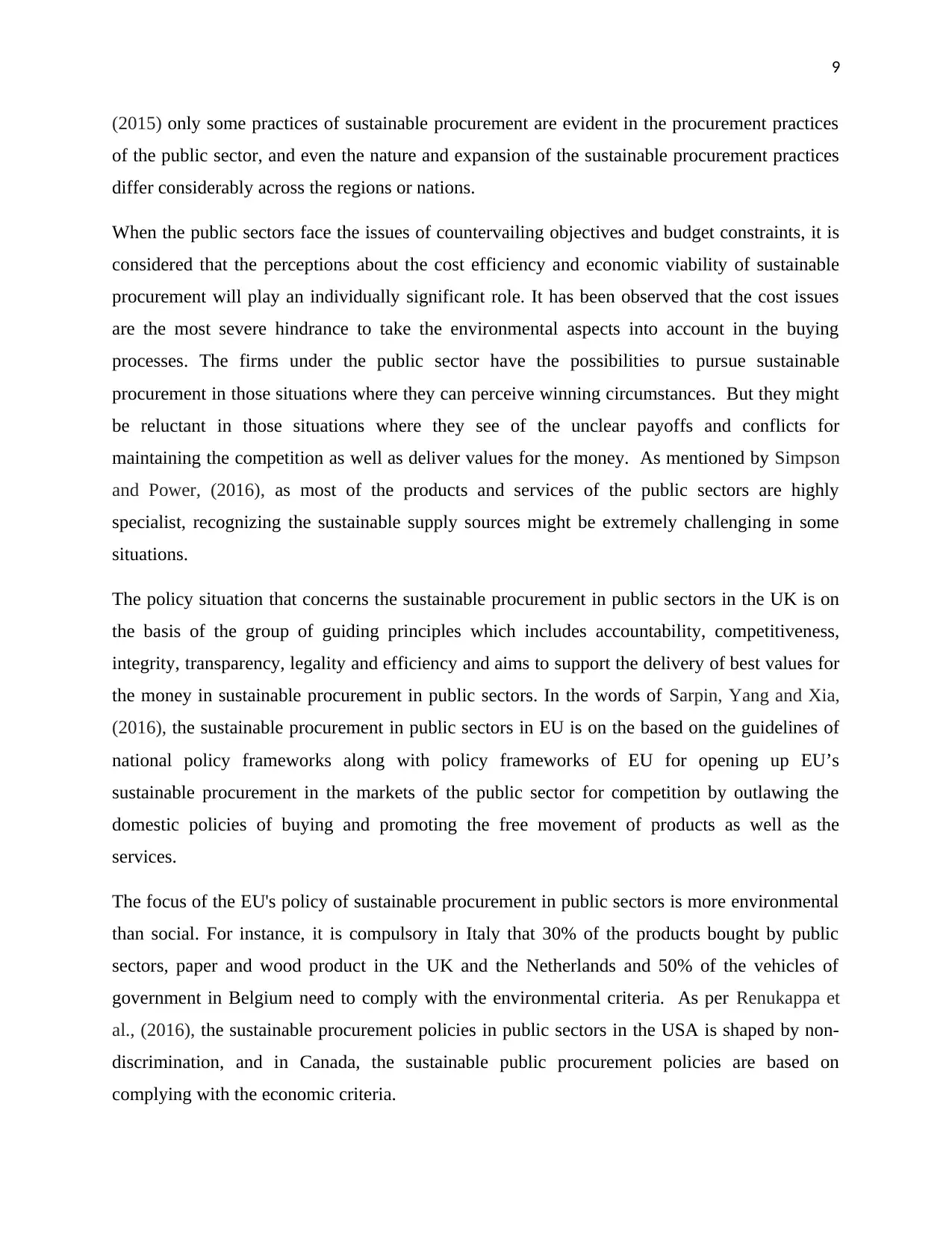
9
(2015) only some practices of sustainable procurement are evident in the procurement practices
of the public sector, and even the nature and expansion of the sustainable procurement practices
differ considerably across the regions or nations.
When the public sectors face the issues of countervailing objectives and budget constraints, it is
considered that the perceptions about the cost efficiency and economic viability of sustainable
procurement will play an individually significant role. It has been observed that the cost issues
are the most severe hindrance to take the environmental aspects into account in the buying
processes. The firms under the public sector have the possibilities to pursue sustainable
procurement in those situations where they can perceive winning circumstances. But they might
be reluctant in those situations where they see of the unclear payoffs and conflicts for
maintaining the competition as well as deliver values for the money. As mentioned by Simpson
and Power, (2016), as most of the products and services of the public sectors are highly
specialist, recognizing the sustainable supply sources might be extremely challenging in some
situations.
The policy situation that concerns the sustainable procurement in public sectors in the UK is on
the basis of the group of guiding principles which includes accountability, competitiveness,
integrity, transparency, legality and efficiency and aims to support the delivery of best values for
the money in sustainable procurement in public sectors. In the words of Sarpin, Yang and Xia,
(2016), the sustainable procurement in public sectors in EU is on the based on the guidelines of
national policy frameworks along with policy frameworks of EU for opening up EU’s
sustainable procurement in the markets of the public sector for competition by outlawing the
domestic policies of buying and promoting the free movement of products as well as the
services.
The focus of the EU's policy of sustainable procurement in public sectors is more environmental
than social. For instance, it is compulsory in Italy that 30% of the products bought by public
sectors, paper and wood product in the UK and the Netherlands and 50% of the vehicles of
government in Belgium need to comply with the environmental criteria. As per Renukappa et
al., (2016), the sustainable procurement policies in public sectors in the USA is shaped by non-
discrimination, and in Canada, the sustainable public procurement policies are based on
complying with the economic criteria.
(2015) only some practices of sustainable procurement are evident in the procurement practices
of the public sector, and even the nature and expansion of the sustainable procurement practices
differ considerably across the regions or nations.
When the public sectors face the issues of countervailing objectives and budget constraints, it is
considered that the perceptions about the cost efficiency and economic viability of sustainable
procurement will play an individually significant role. It has been observed that the cost issues
are the most severe hindrance to take the environmental aspects into account in the buying
processes. The firms under the public sector have the possibilities to pursue sustainable
procurement in those situations where they can perceive winning circumstances. But they might
be reluctant in those situations where they see of the unclear payoffs and conflicts for
maintaining the competition as well as deliver values for the money. As mentioned by Simpson
and Power, (2016), as most of the products and services of the public sectors are highly
specialist, recognizing the sustainable supply sources might be extremely challenging in some
situations.
The policy situation that concerns the sustainable procurement in public sectors in the UK is on
the basis of the group of guiding principles which includes accountability, competitiveness,
integrity, transparency, legality and efficiency and aims to support the delivery of best values for
the money in sustainable procurement in public sectors. In the words of Sarpin, Yang and Xia,
(2016), the sustainable procurement in public sectors in EU is on the based on the guidelines of
national policy frameworks along with policy frameworks of EU for opening up EU’s
sustainable procurement in the markets of the public sector for competition by outlawing the
domestic policies of buying and promoting the free movement of products as well as the
services.
The focus of the EU's policy of sustainable procurement in public sectors is more environmental
than social. For instance, it is compulsory in Italy that 30% of the products bought by public
sectors, paper and wood product in the UK and the Netherlands and 50% of the vehicles of
government in Belgium need to comply with the environmental criteria. As per Renukappa et
al., (2016), the sustainable procurement policies in public sectors in the USA is shaped by non-
discrimination, and in Canada, the sustainable public procurement policies are based on
complying with the economic criteria.
Paraphrase This Document
Need a fresh take? Get an instant paraphrase of this document with our AI Paraphraser
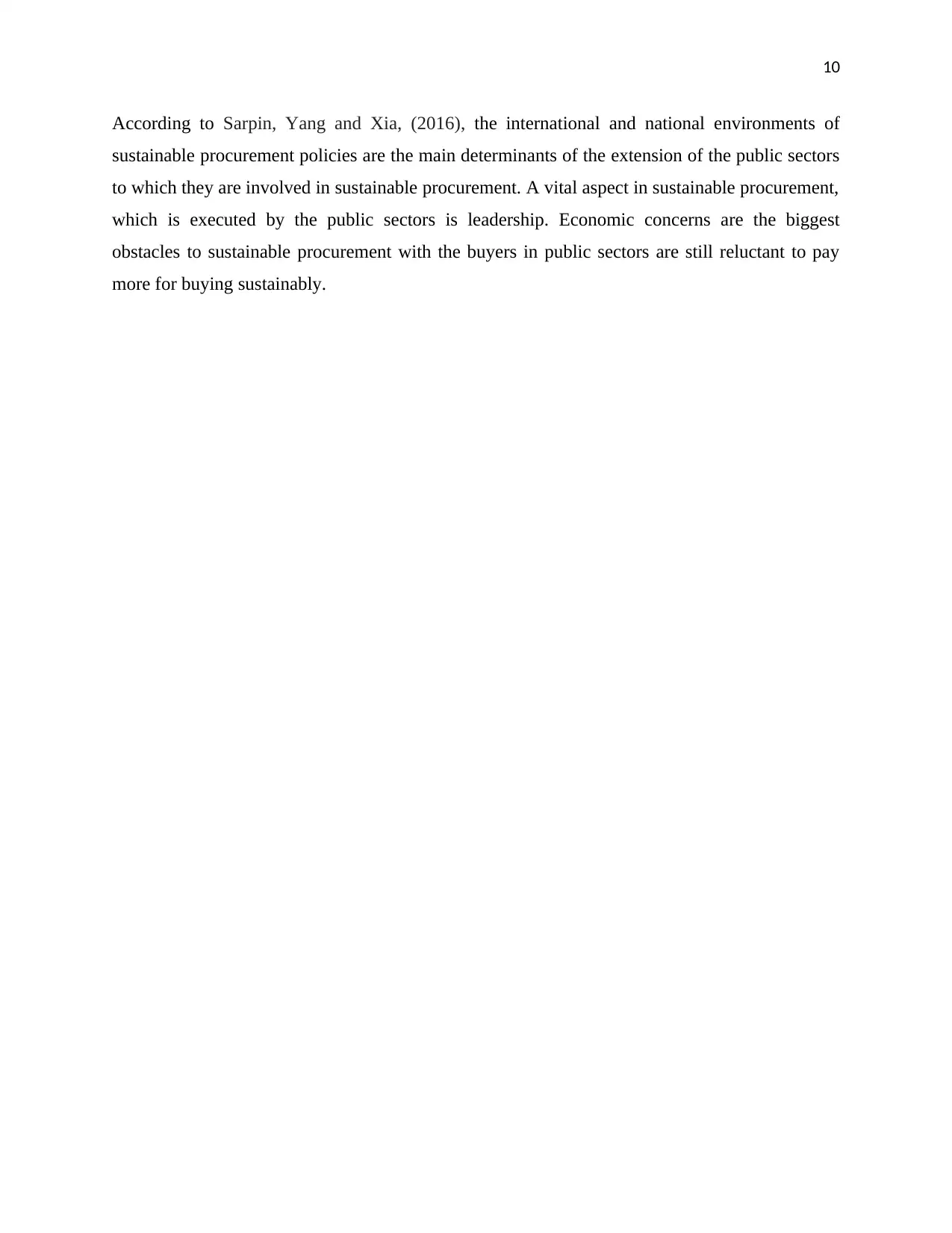
10
According to Sarpin, Yang and Xia, (2016), the international and national environments of
sustainable procurement policies are the main determinants of the extension of the public sectors
to which they are involved in sustainable procurement. A vital aspect in sustainable procurement,
which is executed by the public sectors is leadership. Economic concerns are the biggest
obstacles to sustainable procurement with the buyers in public sectors are still reluctant to pay
more for buying sustainably.
According to Sarpin, Yang and Xia, (2016), the international and national environments of
sustainable procurement policies are the main determinants of the extension of the public sectors
to which they are involved in sustainable procurement. A vital aspect in sustainable procurement,
which is executed by the public sectors is leadership. Economic concerns are the biggest
obstacles to sustainable procurement with the buyers in public sectors are still reluctant to pay
more for buying sustainably.
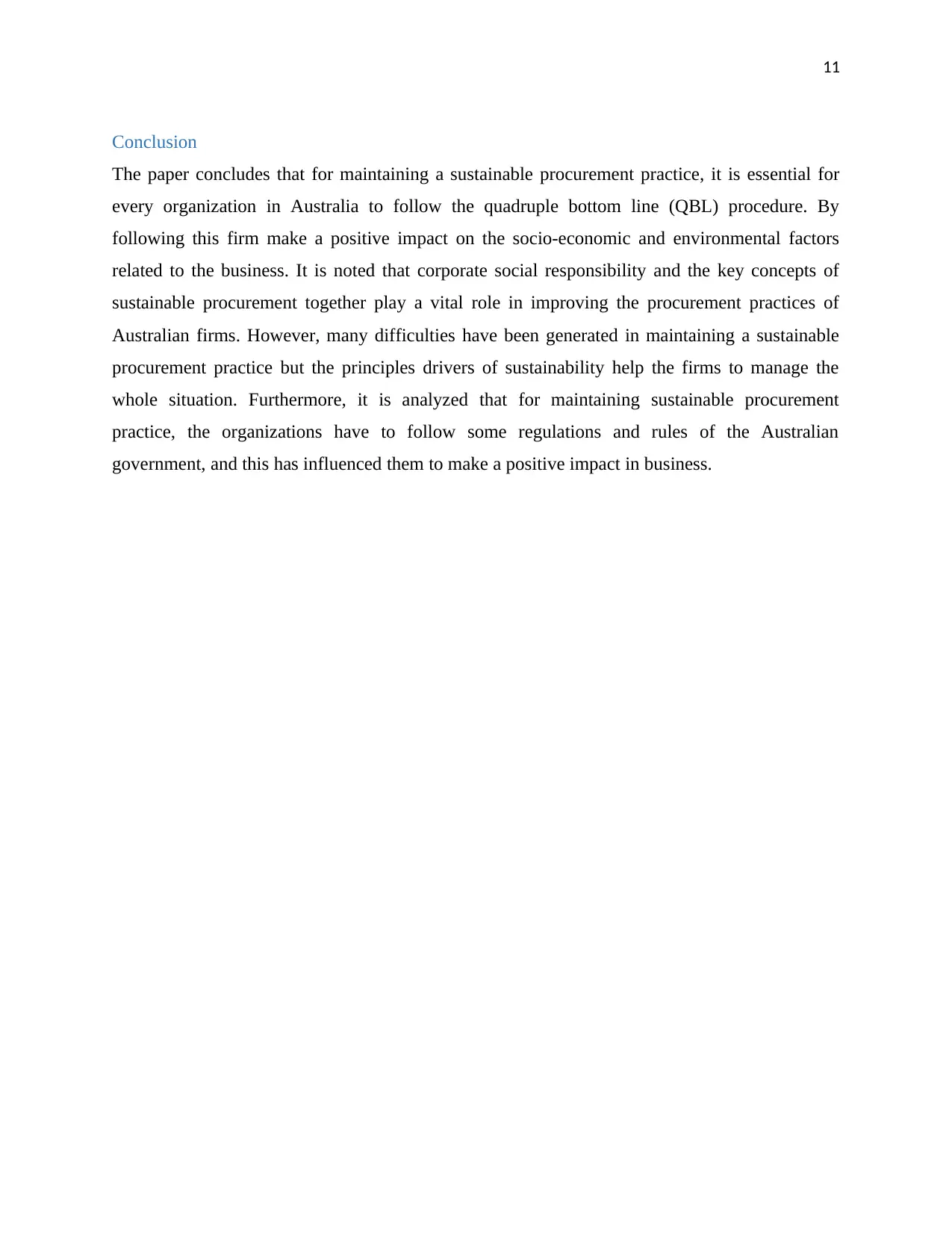
11
Conclusion
The paper concludes that for maintaining a sustainable procurement practice, it is essential for
every organization in Australia to follow the quadruple bottom line (QBL) procedure. By
following this firm make a positive impact on the socio-economic and environmental factors
related to the business. It is noted that corporate social responsibility and the key concepts of
sustainable procurement together play a vital role in improving the procurement practices of
Australian firms. However, many difficulties have been generated in maintaining a sustainable
procurement practice but the principles drivers of sustainability help the firms to manage the
whole situation. Furthermore, it is analyzed that for maintaining sustainable procurement
practice, the organizations have to follow some regulations and rules of the Australian
government, and this has influenced them to make a positive impact in business.
Conclusion
The paper concludes that for maintaining a sustainable procurement practice, it is essential for
every organization in Australia to follow the quadruple bottom line (QBL) procedure. By
following this firm make a positive impact on the socio-economic and environmental factors
related to the business. It is noted that corporate social responsibility and the key concepts of
sustainable procurement together play a vital role in improving the procurement practices of
Australian firms. However, many difficulties have been generated in maintaining a sustainable
procurement practice but the principles drivers of sustainability help the firms to manage the
whole situation. Furthermore, it is analyzed that for maintaining sustainable procurement
practice, the organizations have to follow some regulations and rules of the Australian
government, and this has influenced them to make a positive impact in business.
⊘ This is a preview!⊘
Do you want full access?
Subscribe today to unlock all pages.

Trusted by 1+ million students worldwide
1 out of 15
Related Documents
Your All-in-One AI-Powered Toolkit for Academic Success.
+13062052269
info@desklib.com
Available 24*7 on WhatsApp / Email
![[object Object]](/_next/static/media/star-bottom.7253800d.svg)
Unlock your academic potential
Copyright © 2020–2025 A2Z Services. All Rights Reserved. Developed and managed by ZUCOL.





